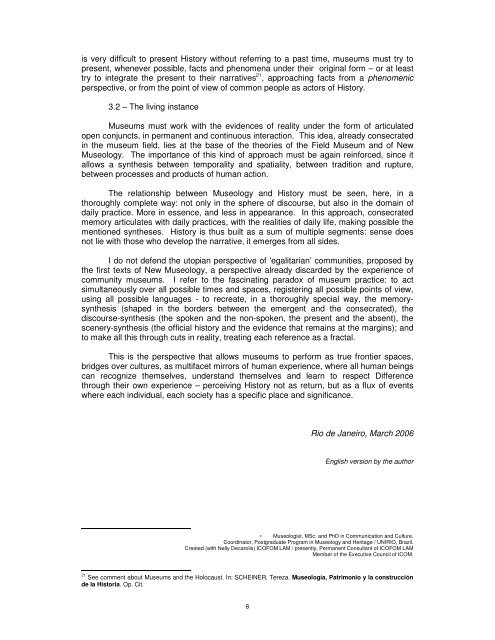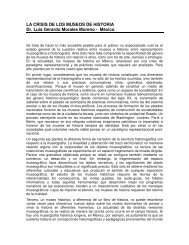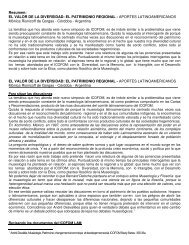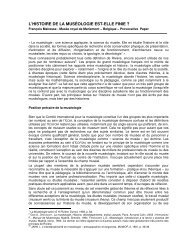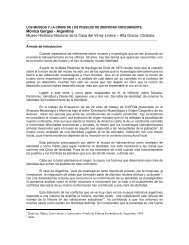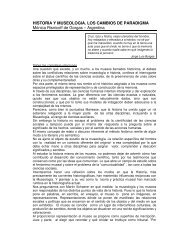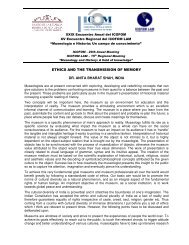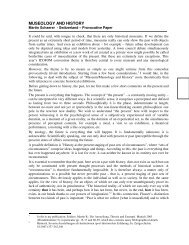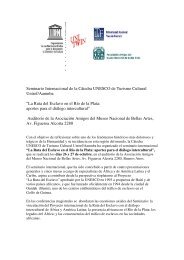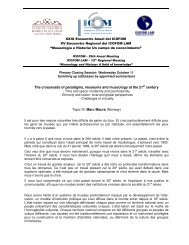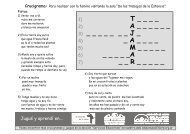MUSEOLOGY AND THE INTERPRETATION OF REALITY: THE ...
MUSEOLOGY AND THE INTERPRETATION OF REALITY: THE ...
MUSEOLOGY AND THE INTERPRETATION OF REALITY: THE ...
- No tags were found...
Create successful ePaper yourself
Turn your PDF publications into a flip-book with our unique Google optimized e-Paper software.
is very difficult to present History without referring to a past time, museums must try topresent, whenever possible, facts and phenomena under their original form – or at leasttry to integrate the present to their narratives 21 , approaching facts from a phenomenicperspective, or from the point of view of common people as actors of History.3.2 – The living instanceMuseums must work with the evidences of reality under the form of articulatedopen conjuncts, in permanent and continuous interaction. This idea, already consecratedin the museum field, lies at the base of the theories of the Field Museum and of NewMuseology. The importance of this kind of approach must be again reinforced, since itallows a synthesis between temporality and spatiality, between tradition and rupture,between processes and products of human action.The relationship between Museology and History must be seen, here, in athoroughly complete way: not only in the sphere of discourse, but also in the domain ofdaily practice. More in essence, and less in appearance. In this approach, consecratedmemory articulates with daily practices, with the realities of daily life, making possible thementioned syntheses. History is thus built as a sum of multiple segments: sense doesnot lie with those who develop the narrative, it emerges from all sides.I do not defend the utopian perspective of ‘egalitarian’ communities, proposed bythe first texts of New Museology, a perspective already discarded by the experience ofcommunity museums. I refer to the fascinating paradox of museum practice: to actsimultaneously over all possible times and spaces, registering all possible points of view,using all possible languages - to recreate, in a thoroughly special way, the memorysynthesis(shaped in the borders between the emergent and the consecrated), thediscourse-synthesis (the spoken and the non-spoken, the present and the absent), thescenery-synthesis (the official history and the evidence that remains at the margins); andto make all this through cuts in reality, treating each reference as a fractal.This is the perspective that allows museums to perform as true frontier spaces,bridges over cultures, as multifacet mirrors of human experience, where all human beingscan recognize themselves, understand themselves and learn to respect Differencethrough their own experience – perceiving History not as return, but as a flux of eventswhere each individual, each society has a specific place and significance.Rio de Janeiro, March 2006English version by the author∗ Museologist, MSc. and PhD in Communication and Culture.Coordinator, Postgraduate Program in Museology and Heritage / UNIRIO, Brazil.Created (with Nelly Decarolis) IC<strong>OF</strong>OM LAM / presently, Permanent Consultant of IC<strong>OF</strong>OM LAMMember of the Executive Council of ICOM.21 See comment about Museums and the Holocaust. In: SCHEINER, Tereza. Museología, Patrimonio y la construcciónde la Historia. Op. Cit.8


